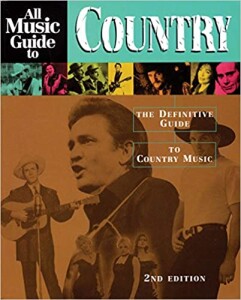 The All Music Guide to Country profiles more than 1,000 musicians and reviews more than 5,500 CDs in the stupefyingly enormous field of country music. It’s a good resource for the fan looking for some help in weeding out the good from the bad, the true “best-of” collections from the rip-off compilations and budget remakes that sadly are too common in the genre.
The All Music Guide to Country profiles more than 1,000 musicians and reviews more than 5,500 CDs in the stupefyingly enormous field of country music. It’s a good resource for the fan looking for some help in weeding out the good from the bad, the true “best-of” collections from the rip-off compilations and budget remakes that sadly are too common in the genre.
AMG Country takes on everything country, from Cajun pioneer Nathan Abshire to progressive country singer-songwriter Steve Young. That means it runs the gamut from Jimmie Rodgers to Kenny Rogers, Steve Earle to Garth Brooks, and attempts to do so in an objective, journalistic way. Each performer’s recordings are rated with one to five diamonds, but as the editors explain up front, a five-diamond Shania Twain record isn’t equal to a five-diamond Dolly Parton; each performer’s records are ranked against their own output. Look for stars in front of an entry: an open star for the best place to start with a certain artist, a black star for an essential recording in the genre.
The book is generally well written and edited, and very well organized. It starts with an excellent Introduction that explains AMG Country‘s purpose as a record buyer’s guide, and makes some important points about country music’s recording history:
…country has a history of poorly assembled studio albums, quickly recorded cash-in albums, budget-priced compilations, and rerecordings. Therefore, even the biggest artists … frequently have discographies that are convoluted and confusing … By one estimation, there have been well over 300 George Jones albums alone.
The front of the book also has a valuable glossary of various country music styles, to help the reader understand the styles listed for each performer.
The back of the book, after the alphabetical listings, has a “various artists” section, and a series of excellent essays on country music history, from old-time traditional country to the current “new country” and “alternative country” scenes. Most of the essays are accompanied by smart “music maps,” which are really org charts, very clean and well-designed graphic presentations of country music’s family tree and its many roots and branches.
Because it covers so much ground, the book’s type is quite small, and may be hard for some to read. The performers’ names don’t always stand out on the page the way they should. Sometimes, AMG Country attempts to cover too much, at least for this book form, as in the entry on Neil Young. Neil is an important country-influenced rocker who has done several essential country-rock records. But albums like Trans and This Note’s For You are not even alt-country by any stretch of the imagination.
AMG Country the book is a “hard copy” adjunct to the All Music website. This is a truly exhaustive on-line database, where things like Young’s entire discography are more appropriate. I encourage anyone interested to check out the website — a lot has happened since this book was first published in early 1997, as becomes apparent in some entries: Lucinda Williams’ award-winning Car Wheels on a Gravel Road isn’t here, nor are a couple of recent Guy Clark albums, or Dolly Parton’s recent comeback records, or the debut of Hank Williams III, etc.
But for the serious collector, AMG Country is a very useful tool and reference, well-written, well-organized and authoritative.
(Miller Freeman 1997)
